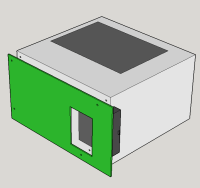ATX Bench Power Supply with USB Hub

I propose re-purposing an ATX (computer) power supply unit as a bench supply with a number of USB type A power outlets (5v) in addition to +/- 12v, 3.3v and 5v for breadboards. The design will additionally feature a USB hub, an FTDI serial port and computer control.
I propose re-purposing an ATX (computer) power supply unit as a bench supply with a number of USB type A power outlets (5v) in addition to +/- 12v, 3.3v and 5v for breadboards. The design will additionally feature a USB hub, an FTDI serial port and computer control.




Discussion (2 comments)
JohnHind 9 years ago
This appears to be the latest Intel ATX Power Supply specification (unless anyone can find a later one?):
http://cache-www.intel.com/cd/00/00/52/37/523796_523796.pdf
Checking some pictures on the internet, some of the Intel mechanical specs seem to be widely ignored, particularly the depth of the unit and the exit position of the wire harness on the rear panel. Also power inlet and switch position are not fully characterised in the spec and the aperature in the PCB may need to be larger to accomodate the variation. The mounting holes and the width and height of the mounting panel must be adhered to reasonably well or PSUs would not be exchangable in cases.
I checked several high-current (>500mA) USB 'wall warts' in my posession. The general scheme seems to be to short the D+ and D- in the A-Socket for a power-only connection delivering a nominal 2A (for example, a tablet or phone charger). This suggests some dedicated high-current A sockets in addition to some on a hub (which will be limited to 500mA).
I think we want more than four ports on the USB hub bearing in mind that one, possibly 2 ports will be taken up by control and serial port. I found this seven port chip:
http://www.ti.com/product/tusb2077a
USB-3 is tempting and gives more power flexibility, but on the whole it is probably over-kill in this application - any views on this?
Now please tell me: on what planet is 'Hi Speed' faster than 'Full Speed' - oh yes, planet Standards Committee!
JohnHind 9 years ago
ATX computer power supplies are a tempting prospect for re-purposing for project or lab use. Mass production and extensive competition have made them excellent value and standardization to Intel's specification make them a known quantity. This idea has occurred to others before. Elektor published a breakout board designed by Ben Jordan in June 2013 and Sparkfun make a simple commercial kit.
These designs fail to hit the mark for me, and I thought I could do better.
First off, the standard mounting features of the ATX supply should allow us to make a breakout board which mounts on the supply case using simple stand-offs. This will make a self-contained unit without any mechanical construction. Sketchup models are presented to show the concept. The circuit board (in traditional green) overhangs the right-hand edge of the PSU to accommodate a standard motherboard plug (dark grey) on the back. The cable can thus be bunched up along the left side and the back of the unit tidy and out of the way. The cutout in the board allows access for the mains lead and (if you are lucky) the mains isolater switch. The board will be mounted with four bolts into the threaded holes thoughtfully provided in the ATX standard and spaced with simple stand-offs. This allows cooling airflow into the PSU which will also cool any components mounted on the back of our circuit board.
Looking around my lab bench, I see that a clear majority of my equipment takes power from a USB connector, either a cable with an 'A' connector on one end and a mini or micro USB connector on the other (or ocassionally a full sized USB 'B' connector), or a USB 'A' connector actually formed as part of the PCB. Many of these devices do not even communicate over USB but just use it as a handy source of power. This suggests that our design should have numerous USB 'A' sockets fed from the 5v. available from the PSU.
Having realised this, the next logical step was to incorporate a USB hub into the design so that at least some of these 'A' sockets could communicate as well as supply power.
With a hub present we may as well include the possibility of computer control of the unit, avoiding the need for a physical UI. Plus it would be good to throw in an FTDI serial link (3.3v or 5v logic selectable) with an Elektor ECC connector of course!
One of the problems of using a computer power supply in this way is the fact that even the lowest wattage units really produce far too much current for most lab projects bringing the possibility of serious damage and even some unintended arc welding! Some kind of current limiting is really essential. The Sparkfun design has fuses (in my lab that could get expensive!) whilst the Elektor design ... well lets just say it's not for wimps like me! I'm still thinking about this, but a simple collective 'electronic fuse' which measures current and uses the logic on/off switch to cut the supply if any output goes over limit is my current (pun not initially intended!) thinking (comments very welcome on this and and other aspects of the design).
atx-003.png (4kb)
ClemensValens 9 years ago
JohnHind 9 years ago
ClemensValens 9 years ago